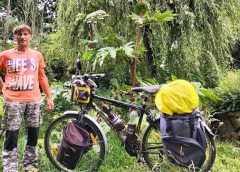
The man who cycled 870 miles for a croissant
[ad_1]
(CNN) — Albert Van Limbergen set off by bike on June 28 from his home just outside of Liège, Belgium, in search of a croissant.
But rather than heading around the corner to a local shop, he was en route to southern France. Two weeks later, on July 12, he reached his destination: Boulangerie Roy Le Capitole, artisan baker Frédéric Roy’s unassuming neighborhood bakery one street back from the Mediterranean Sea in Nice.
Albert arrived mid-afternoon to applause from a small crowd including Frédéric and his wife, Katia. He was still dressed in the cycling gear he’d worn for the last leg of his journey: a red hat, a yellow polo shirt and black bike shorts, the colors of the Belgian flag. And he didn’t wait long to taste what he had cycled more than 1,400 kilometers (870 miles) across two countries for: one of Frédéric’s signature croissants made using lavender grown on a wide limestone plateau high up in the Côte d’Azur hinterland.
Admiring the faint violet hue (all that remains once a layer of bright food coloring cooks off in the oven), Albert took a bite through the flaky crust and into the feather-like layers of buttery pastry inside, remarking upon the subtle but distinct herb flavor — the result of lavender-infused water that is kneaded into the dough mixture before baking.
Frédéric said his bakery is the only one he knows of to sell such a flavored viennoiserie, the French term for the group of sweet baked pastries such as croissants, pains au chocolat and pains aux raisins.
And when Albert, flicking through TV channels at home one day, stumbled upon a segment on the news about a Nice baker and his lavender croissants, the seed for his two-wheel adventure was sown.
For someone who admits to adoring everything about lavender “from the smell to the taste and the fields of blue, green and violet,” Albert found himself galvanized.
The trip wasn’t the first time the retired transport professional had based his travels around his favorite plant.
“If I had a few days off from work, I’d sometimes drive to the Ardèche in France to eat lavender ice cream at Vallon-Pont-d’Arc,” he says.
Nor was it the first time that he’d cycled great distances for pleasure. Previously, he’d reached Perpignan, toward the Spanish border on France’s western Mediterranean coast.
It was, however, the first time he’d set off in search of new lavender flavor experiences by bike.

Lavender fields along the route provided a preview of the flavor that motivated Albert Van Limbergen to cycle to southern France.
Albert VanLimbergen
False starts and finally, departure
On the Côte d’Azur, Frédéric first heard of Albert in early 2021 when one of Albert’s friends, half in jest, fired off a handwritten letter to the boulanger.
“If at the end of June, you see Albert arrive on his bike, that will be the objective, the goal of his voyage (achieved),” the author wrote.
Not long after, another set of Belgian friends on holiday in the seaside resort visited the bakery and passed on Albert’s phone number. The pair soon spoke for the first time, and a plan was hatched for June that year.
“There were a few things that got in the way,” Albert explains — namely pandemic-driven travel restrictions. “But it all served as motivation to get on the road as early as possible in 2022.”
Finally, a year later, he was ready to depart.
Three friends had volunteered to look after his beloved rescue animals, a farmyard full of horses, cats, dogs and fish, while he was away. Carrying little more than a sleeping bag, a tent, a change of clothes, tools for bike repairs and 7 liters of drink — and sporting flip-flops, his footwear of choice — he started to pedal.
The itinerary he plotted out took him past the Belgian cities of Ciney and Dinant, crossing into France near Charleville-Mézières. He headed south past Burgundy’s vineyards to Lyon and then followed the Rhône River to Valence where he prepared to tackle the 1,180-meter (about 3,870 feet) summit of the Col de Cabre mountain pass.

Frédéric Roy and Albert Van Limbergen met at Roy’s boulangerie in Nice, France.
Frederic Roy
Once crossed, the lavender-hued landscapes of northern Provence were his reward. Closer to Nice, there were the red-ochre gorges of the Mercantour National Park to navigate before he finally swept up onto the Promenade des Anglais and a view of the city’s famous Baie des Anges to accompany the final few kilometers.
“I carefully planned a route along smaller rural roads to avoid motorways, busy regional roads and cars as much as possible,” Albert says. He averaged 12 hours (including stops) and 100 kilometers (62 miles) a day.
“I’d stop for a plat du jour (daily special) for lunch and at night, I’d pitch up in a campsite,” he says. There were just a few hours of bad weather to contend with across the whole two weeks.
He kept in daily contact with Frédéric, sending photos and sharing his geopositioning.
“Frédéric followed me,” Albert says. “He knew when I was stopping in a restaurant, for a beer, at a campsite, even by the side of the road. He just couldn’t actually see me.”
Frédéric kept his nearly 10,000 Twitter followers updated on Albert’s progress, posting his photos and often a map of the day’s route.
The afternoon when Albert finally arrived, Frédéric was ready to celebrate with local beer and red, yellow and black balloons — and, of course, a plate of fresh lavender croissants.
“We chatted for a few hours about lavender, nature and life in general,” says Frédéric, speaking to CNN Travel by phone. “He came back the next day, and we spoke for a few hours more.”

Lavender-infused water is kneaded into the croissant dough. The food coloring that gives them this bright hue mostly bakes off in the oven.
Frederic Roy
The Croissant Crusader
Frédéric first started making lavender croissants two-and-a-half years ago, adding them to an unconventional range that includes raspberry, pistachio, choco-banana and hazelnut-flavored croissants that sells alongside the more classic assortment of viennoiseries.
He’s been hooked on his craft ever since he started as an apprentice baker in his early teens, despite the 4:30 a.m. starts six days a week.
As France grapples with claims that up to 80% of croissants sold across the country today are ready-made, mass-produced versions cooked from frozen, Frédéric is emerging as the nation’s croissant crusader, a figure out to champion the traditional, homemade croissant that is so integral to its culinary heritage. It’s very fitting for someone whose surname is a homonym of “roi,” the French word for king.
He’s dedicated much of the past five years to petitioning the country’s politicians for a croissant de tradition française (traditional French croissant) label, similar to what already exists for the baguette.
“Some bakers have never actually made a croissant in their lives,” he says. “I just want people to know what they are buying.”
At Boulangerie Roy Le Capitole, that’s a croissant that’s taken three days to make — the sweet spot to achieve the perfect consistency and a slightly nutty flavor, according to Frédéric — using only the finest quality ingredients, including 100% pure French unsalted butter.
He can bake up to 1,200 pur beurre (100% butter) croissants a day, depending on the time of year. Besides the fresh-from-the-oven crates that he hand delivers to Nice’s legendary Hotel Negresco — the beachfront five-star hotel that welcomes politicians, royalties and celebrities — for breakfast every morning, he is usually sold out by lunch.
On weekends, it’s not unusual for the queue outside his bakery to wind around the street corner.
Room for improvement
As for Albert, he spent two days sightseeing in Nice before starting the long journey back to Belgium. This time, though, he only had to cycle the roughly 70 kilometers (43 miles) from Nice to the small inland village of Puget-Théniers, where a friend had driven to pick him and his bike up.
And what did he think of Frédéric’s lavender croissants? Were they worth the two-week journey?
“They were good, but I think they could be improved even more,” he says. “In Belgium, we often put pastry cream in croissants. Lavender and pastry cream, now that would be magnificent.”
Chrissie McClatchie is a Nice-based travel writer and guidebook author whose stories from the Côte d’Azur and beyond have appeared in BBC Travel, Condé Nast Traveler, Lonely Planet and more.
[ad_2]
Source link


